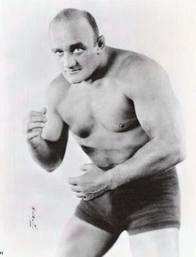Wladek Zbyszko
| Wladek Zbyszko | |
|---|---|
 Wladek Zbyszko in his prime | |
| Birth name | Władysław Cyganiewicz |
| Born |
November 20, 1891[1] Kraków, Austria-Hungary[1] (now Poland) |
| Died |
June 10, 1968 (aged 76)[1] Savannah, Missouri, United States[1] |
| Family | Stanislaus Zbyszko (brother)[1] |
| Professional wrestling career | |
| Ring name(s) |
Great Apollo Wladek Cyganiewicz Wladek Zbyszko |
| Billed weight | 225 lb (16 st 1 lb; 102 kg)[2] |
| Trained by | Stanislaus Zbyszko |
| Retired | 1950 |
Władysław Cyganiewicz (November 20, 1891 – June 10, 1968), better know by the ring name Wladek Zbyszko, was a Polish professional wrestler and strongman. He is the brother of Stanislaus Zbyszko. "Zbyszko" was a childhood nickname of his older brother Stanislaus, the name of a fictional medieval Polish knight from the historical novel "Krzyżacy" by Henryk Sienkiewicz, that Stanislaus and later Wladek would both use as their ring name.
Personal life
Władysław Cyganiewicz was born in 1891 in Kraków, Galicia, Austria-Hungary, in what is known as Poland. He studied at the University of Krakow and would later receive a degree in Law from the University of Vienna.[1] Besides his exploits in the ring he was also considered an excellent pianist.[1]
Professional wrestling career
Cyganiewicz followed his other brother Stanislaus Zbyszko into a career in professional wrestling adopting the "Zbyszko" surname as his ring name. He began his career in Europe but emigrated to the United States of America in the 1910s, where he was billed as the "Youngest European Champion" ever.[2] He made his American debut on January 17, 1913 in Chicago defeating his opponent, Alexander Angeloff, in short order. On January 8, 1917 Zbyszko defeated Ed "Strangler" Lewis to win the American Heavyweight Championship, considered one of the original nationally recognized championships in professional wrestling.[3] Zbyszko claimed the Boston version of the AWA World Heavyweight Championship after defeating the champiob Ed Lewis in one fall on June 5, 1917.[4] After the match Zbyszko claimed to be the champion while Lewis disputed that claim.[4] On July 4, 1917 in Boston he lost to Lewis, only to defeat him again on December 22, 1917 in New York to further his claim to the championship, a claim also made by Joe Stecher and Lewis.[4] Zbyszko lost his version of the World Heavyweight Championship to Earl Caddock on February 8, 1918 in Des Moines, and lost again to Ed Lewis on May 19, 1918 to end his claim to the championship.[4] Wladek Zbyszko was still billed as the American Heavyweight Champion as late as September 22, 1922 after which that title was abandoned in lieu of various "World" Championships.[3] Over the years the Zbyszko brothers would toured both through Europe as well as South America, at times bringing with them a troupe of American wrestlers to put on shows.[1] During one such tour of Brazil, Zbyszko had a wrestling match against Helio Gracie on October 6, 1934, with Zbyszko winning by armlock. The match was George Gracie's first ever loss in a competitive match.[5] Zybszko wrestled as late as 1950 before retiring to a farm in Savannah, Missouri.[1] He died on June 10, 1968, aged 76.
Championships and accomplishments
- American Wrestling Association (Boston)
- AWA World Heavyweight Championship (Boston version) (2 times, disputed)[4]
- Other Titles
- Professional Wrestling Hall of Fame and Museum
- Pioneer Era: Class of 2009[1]
- Wrestling Observer Newsletter
References
- 1 2 3 4 5 6 7 8 9 10 Luce, Don. "Wladek Zbyszko". Pro Wrestling Hall of Fame. Retrieved April 6, 2015.
- 1 2 "Europe's Youngest Champion Wladek Cyganiewicz Zbyszko". New York City: Department of Records. Retrieved April 6, 2015.
- 1 2 3 Royal Duncan and Gary Will (2000). "American Heavyweight Title". Wrestling Title Histories. Archeus Communications. ISBN 0-9698161-5-4.
- 1 2 3 4 5 Royal Duncan and Gary Will (2000). "Boston: American Wrestling Association World Heavyweight title". Wrestling Title Histories. Archeus Communications. ISBN 0-9698161-5-4.
- ↑ "George Gracie - Facts and bio". BJJ Heroes. Retrieved April 6, 2015.
- ↑ "American Heavyweight Title history". Wrestling-Titles.com. Retrieved April 6, 2015.
- ↑ Meltzer, Dave (October 25, 2010). "Wrestling Observer Hall of Fame". Wrestling Observer Newsletter. Campbell, CA: 19–25. ISSN 1083-9593.